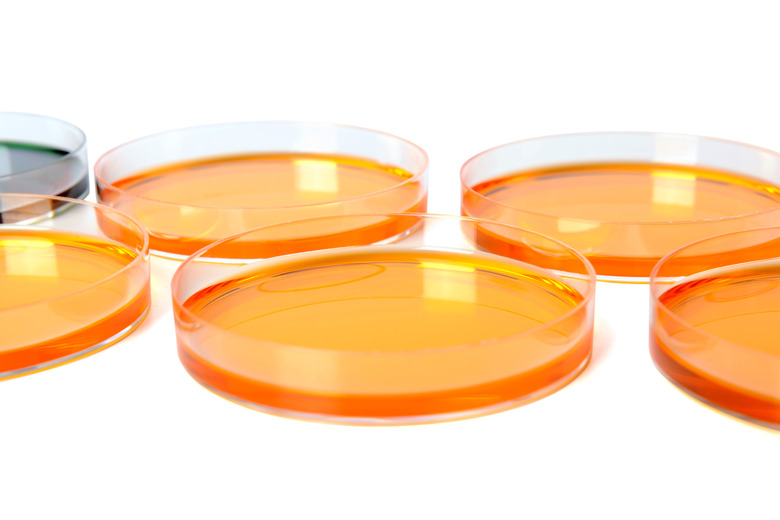How To Calculate CFU From Dilution
Your teacher hands you a sample of bacteria and asks you: How many viable microorganisms are in this sample? What does this mean, and how do you figure it out? One methhod is by finding the number of colony forming units **(CFU)**.
What Are CFU?
What Are CFU?
CFU refer to the number of individual colonies of any microorganism that grow on a plate of media. This value in turn represents the number of bacteria capable of replicating as they have formed colonies on the plate. There is a CFU formula which involves sampling.
How Do You Find CFU?
How Do You Find CFU?
Counting the number of bacteria in a liquid sample is very difficult. There are too many of them, and they are too small. Furthermore, some of them may be dead and others alive, and the dead ones should not count toward the total. You are only interested in viable bacteria, or bacteria that can replicate. So how can you figure out how many bacteria you have?
In the same way that you can take a poll of 1,000 people and apply it to 10,000 people to figure out how they might think about a certain subject. You can try and take a small part of your original sample, figure out how many bacteria there are in that part, and then calculate to approximate out how many there might have been in the original sample.
Using Dilutions to Find CFU
Using Dilutions to Find CFU
The procedure to find CFU of a given sample involves first diluting that sample. The dilutions are then plated onto plates with the correct growth medium. Multiple dilutions are often a good idea since the original sample can be very concentrated.
After allowing the bacteria to grow on the plates for a given amount of time, individual colonies are counted on a plate. If the sample was too concentrated then instead of individual colonies you will see a large area covered with bacterial growth which is called a lawn. This means you should further dilute your sample and try growing again so that you can see individual colonies.
As individual colonies come from a single bacteria that replicated itself many times over, only these count toward the CFU.
Experimental Procedure for Finding CFU
Experimental Procedure for Finding CFU
An example of using dilutions to do a CFU calculation could go as follows: First, from the initial sample your teacher gives you, you take 1 mL and plate it. The next day you see that there is a lawn of bacteria. This means you cannot count the number of CFU. The next step is making some dilutions.
First, you take 1 mL of sample and dilute it into 9 mL of liquid media. Since the dilution is one part sample to nine parts diluent, it is referred to as a 1:10 dilution. Then, you take 1 mL of the 1:10 dilution and add that to 9 mL of liquid media. This dilution is a 1:100 dilution. Lastly you make a 1:1,000 dilution by taking 1 mL of the 1:100 dilution and adding 9 mL of liquid media. For each dilution, you now have 10 mL of diluted bacterial culture.
Dilutions done, you plate 0.5 mL of the dilutions onto plates. Make sure to label the plates with which dilution was plated.
The next day you come back and see that all the plates have some individual colonies on them. You want to pick a plate between 30 and 300 colonies. You see that the 1:1,000 dilution plate has about 10 colonies so that means you over diluted the sample. That plate is not going to be helpful in finding CFU.
The 1:10 dilution plate has many colonies, maybe more than 300. In that case you can go onto the 1:100 plate. You count the colonies on this plate and find that it has 179 colonies. This means that 0.5 mL of the 1:100 dilution contains 179 CFU. But what about the original sample?
What is CFU Calculation?
What is CFU Calculation?
Now that you have some data, you can do the CFU calculation in the original sample.
1\. Take the amount you plated (0.5 mL) and multiply by the dilution factor (0.01) to yield 0.005. You must do this to find the dilution factor which yielded your CFU count. Here, half a milliliter of the 1:100 dilution allowed you to count CFU.
2\. Divide the CFU from the dilution (179) by the result from Step 1 (0.005) to yield 35,800 CFU.
This means that the original 1 mL of sample that was diluted contains 35,800 CFU. Another way to put this is to say that the original sample has 35,800 CFU/mL.
CFU is a great tool to find how many bacteria, fungi or any microorganisms there are in a given sample. The plating method described here is particularly helpful for very concentrated samples or organisms that don't grow well in liquid culture.
References
Cite This Article
MLA
Gupta, Riti. "How To Calculate CFU From Dilution" sciencing.com, https://www.sciencing.com/calculate-cfu-dilution-7806269/. 1 February 2020.
APA
Gupta, Riti. (2020, February 1). How To Calculate CFU From Dilution. sciencing.com. Retrieved from https://www.sciencing.com/calculate-cfu-dilution-7806269/
Chicago
Gupta, Riti. How To Calculate CFU From Dilution last modified March 24, 2022. https://www.sciencing.com/calculate-cfu-dilution-7806269/
